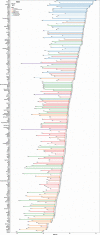A century of trends in adult human height
- PMID: 27458798
- PMCID: PMC4961475
- DOI: 10.7554/eLife.13410
A century of trends in adult human height
Abstract
Being taller is associated with enhanced longevity, and higher education and earnings. We reanalysed 1472 population-based studies, with measurement of height on more than 18.6 million participants to estimate mean height for people born between 1896 and 1996 in 200 countries. The largest gain in adult height over the past century has occurred in South Korean women and Iranian men, who became 20.2 cm (95% credible interval 17.5-22.7) and 16.5 cm (13.3-19.7) taller, respectively. In contrast, there was little change in adult height in some sub-Saharan African countries and in South Asia over the century of analysis. The tallest people over these 100 years are men born in the Netherlands in the last quarter of 20th century, whose average heights surpassed 182.5 cm, and the shortest were women born in Guatemala in 1896 (140.3 cm; 135.8-144.8). The height differential between the tallest and shortest populations was 19-20 cm a century ago, and has remained the same for women and increased for men a century later despite substantial changes in the ranking of countries.
Keywords: biological sciences; epidemiology; global health; medical research; none; nutrition.
Conflict of interest statement
The authors declare that no competing interests exist.
Figures











References
-
- Adair LS, Fall CH, Osmond C, Stein AD, Martorell R, Ramirez-Zea M, Sachdev HS, Dahly DL, Bas I, Norris SA, Micklesfield L, Hallal P, Victora CG, COHORTS group Associations of linear growth and relative weight gain during early life with adult health and human capital in countries of low and middle income: findings from five birth cohort studies. Lancet. 2013;382:525–534. doi: 10.1016/S0140-6736(13)60103-8. - DOI - PMC - PubMed
-
- Baten J, Blum M. Growing Tall but Unequal: Findings and New Background Evidence on Anthropometric Welfare in 156 Countries, 1810–1989. Economic History of Developing Regions. 2012;27:S66–S85. doi: 10.1080/20780389.2012.657489. - DOI
MeSH terms
Grants and funding
- MC_U147574242/MRC_/Medical Research Council/United Kingdom
- PG/13/66/30442/BHF_/British Heart Foundation/United Kingdom
- MC_U147585827/MRC_/Medical Research Council/United Kingdom
- MR/N003284/1/MRC_/Medical Research Council/United Kingdom
- MC_U147574245/MRC_/Medical Research Council/United Kingdom
- MC_UU_12011/2/MRC_/Medical Research Council/United Kingdom
- MC_UU_12019/1/MRC_/Medical Research Council/United Kingdom
- G0401527/MRC_/Medical Research Council/United Kingdom
- 100693/WT_/Wellcome Trust/United Kingdom
- MC_U147574218/MRC_/Medical Research Council/United Kingdom
- R01 HL093093/HL/NHLBI NIH HHS/United States
- RG/13/16/30528/BHF_/British Heart Foundation/United Kingdom
- MC_UU_12011/4/MRC_/Medical Research Council/United Kingdom
- MC_U147585824/MRC_/Medical Research Council/United Kingdom
- MC_UP_A620_1015/MRC_/Medical Research Council/United Kingdom
- P01 HD031921/HD/NICHD NIH HHS/United States
- MC_U147585819/MRC_/Medical Research Council/United Kingdom
- G1000143/MRC_/Medical Research Council/United Kingdom
- RG/08/013/25942/BHF_/British Heart Foundation/United Kingdom
- MC_UU_12015/1/MRC_/Medical Research Council/United Kingdom
- MC_UP_A620_1014/MRC_/Medical Research Council/United Kingdom
- MC_UU_12011/3/MRC_/Medical Research Council/United Kingdom
- PG/05/046/18730/BHF_/British Heart Foundation/United Kingdom
- MR/K006584/1/MRC_/Medical Research Council/United Kingdom
- MC_UU_12011/1/MRC_/Medical Research Council/United Kingdom
- G0400491/MRC_/Medical Research Council/United Kingdom
- MC_UP_A620_1016/MRC_/Medical Research Council/United Kingdom
LinkOut - more resources
Full Text Sources
Other Literature Sources
Miscellaneous

